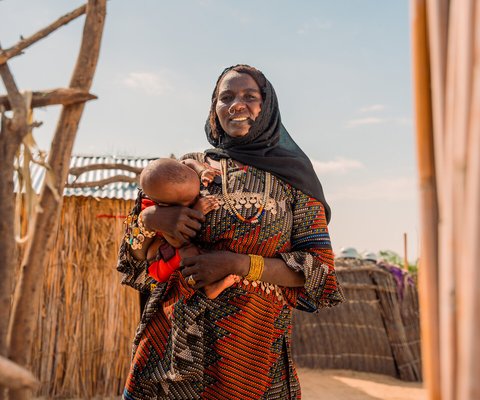When a deadly storm struck Mindanao, Oxfam’s work to strengthen local humanitarian leaders was put to the test.
The Davao is not a tame river. For all its glassy surface and gentle curves, it is capable of rising 20 or 30 feet with breathtaking speed, overwhelming the communities perched on its banks. That’s what happened in December 2017, when Typhoon Vinta struck the Philippine island of Mindanao.
“We were all shocked,” says Pricarda Malinao, who lost her shop to the flood, along with much of the land it stood on. Thirty-five houses in her village—a third of the total—were destroyed. But when community members gather to talk about that day, there is an unmistakable tone of pride in their voices: they were well prepared for a flood emergency, and the actions they took saved lives.
Families who live on the banks of the Davao eke out a living by taking in laundry, hauling carts from door to door to collect garbage, or scooping sand from the bottom of the river to sell as construction material. In other words, they are poor, and around the world it is the poorest people who suffer most when disaster strikes. Of course, vulnerable doesn’t mean helpless; in communities where resources are scarce, the ethics of sharing and protecting one another often runs deep, and stories abound of heroism in the face of disaster.
But it takes more than good will and spontaneous acts of courage to ensure that every family in harm’s way makes it to safety: it takes knowledge, skills, practice, and a few resources.

We follow their lead
In April 2015, Oxfam joined forces with Tearfund and Christian Aid in a three-year pilot project aimed at strengthening the ability of local organizations and communities in the Philippines to handle disasters without significant help from international agencies. It is called the Financial Enablers Project, or FEP.
“We set out not only to strengthen local knowledge and capacity,” says Jane Bañez-Ockelford, who led the project for Oxfam, “but also to build local leadership—to help develop effective, confident, proactive decision makers.”
There is nothing new about international agencies supporting capacity-building efforts in countries prone to disasters. What’s different about the FEP is that the international agencies didn’t tell the Filipinos what to do with the money.
“The partners we work with define their own needs and gaps and design their own capacity-development plans,” says Bañez-Ockelford. “We follow their lead.”
Some organizations needed to improve their financial systems; others needed to sharpen their skills in carrying out assessments and providing clean water in emergencies. Each underwent a rigorous self-assessment and came up with a proposal that the FEP then supported.
It’s all part of a plan to shift power and resources traditionally held by international organizations to the humanitarians working closer to home.
“At the heart of our humanitarian ethos is the power of people,” says Winnie Byanyima, executive director of Oxfam International. “It pushes us to move decision-making and power to where it should be: in the hands of people most affected by crises.”

Zero casualties
In the months before the typhoon struck, a group of FEP-funded organizations—MAGI, Minland, APILA, IDIS, and DMSF-IPHC, collectively known as MMAID—worked with 15 riverside communities to prepare for just such an emergency. They helped villagers set up an early warning system in which upland communities would warn people living downstream of impending floods, and where painted markers along the river would enable residents to monitor the water as it rose. The agencies encouraged communities to form emergency committees, and trained them in everything from evacuation planning to first aid to health and hygiene in emergencies. They provided the local teams with rescue equipment, and carried out simulations to help everyone understand what to do and when to do it. When the real emergency hit, evacuations were timely and effective.
The price tag for training and equipping 154 community-level responders? Less than $20,000.
Community team leader Armando Amancio experienced a similar flood in 2013. Last time, he says, “there had been no training in advance and we had no equipment. Our response was completely disorganized. There was no monitoring of hygiene and sanitation and no immunizations, and there were serious health problems afterward. People came down with leptospirosis, dengue, flu, and diarrhea. One person died of tetanus from a puncture wound. This time, the health problems were mild.”
And while more than 200 people died in Typhoon Vinta, in the areas where Oxfam’s FEP partners were working, there were no casualties.
“These communities knew what they had to do to save lives, and they did it,” says Ruth Villasin, an organizer from one of the local aid groups. “They lost a lot, but in some ways they are stronger than ever.”
Learn more about Oxfam’s initiative on local humanitarian leadership at oxfamamerica.org/local-leaders, and about the Financial Enablers Project at startnetwork.org/financial-enablers.


